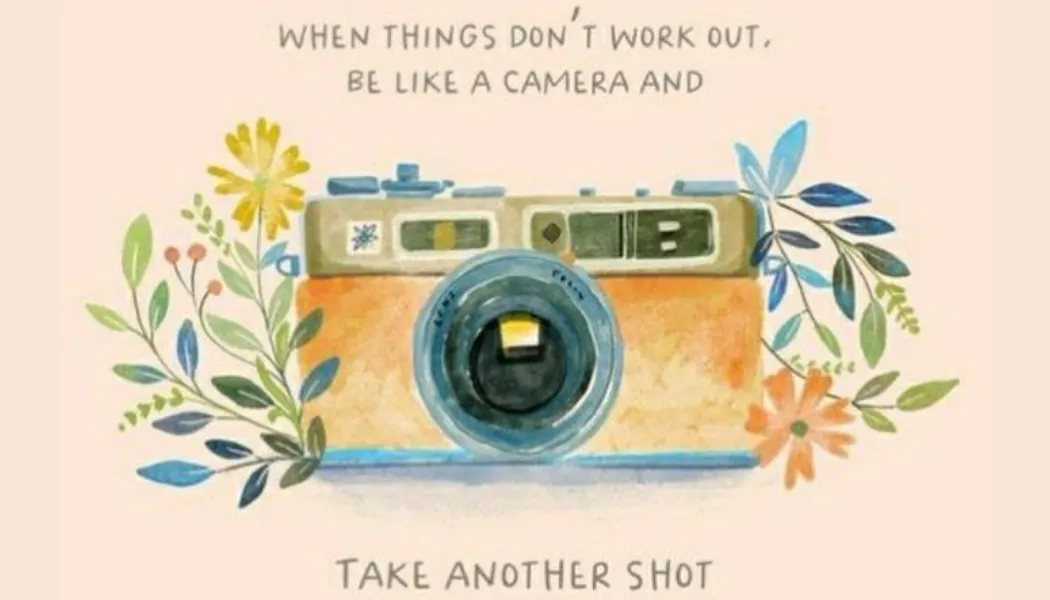Life doesn’t always go as planned. No matter how carefully we frame our goals, sometimes the picture comes out blurry. We work hard, we prepare, we dream big — and yet, outcomes slip through our fingers. It’s in those moments that disappointment and self-doubt sneak in. But as the quote reminds us, “When things don’t work out, be like a camera and take another shot.”
A camera captures moments, both perfect and imperfect. It adjusts to lighting, angles, and perspective. When an image doesn’t turn out right, we don’t throw the camera away — we simply change our focus and try again. The same is true for life. Failure is not a final snapshot; it’s just a test shot before the masterpiece.
This quote is a powerful reminder that setbacks are not the end — they are redirections. Like a photographer behind the lens, you can always shift your focus, reframe your perspective, and capture a new moment.
Table of contents
- The Art of Perspective
- Embracing Failure as Part of the Process
- Resilience: The Power of Taking Another Shot
- Learning to Adjust the Focus
- The Importance of Light and Shadow
- Capturing the Present Moment
- The Beauty of Editing: Growth After Failure
- The Courage to Experiment
- The Value of Patience
- Finding Joy in the Process
- Turning Mistakes into Masterpieces
- The Importance of Reflection
- Building a Personal Album of Growth
- Conclusion: Keep Clicking, Keep Living
The Art of Perspective
Photography is all about perspective. What appears ordinary from one angle can become extraordinary from another. The same applies to how we see our challenges. When things don’t work out, it’s easy to fixate on what went wrong. But stepping back, adjusting our “lens,” and viewing the situation differently often reveals hidden opportunities.
Consider a failed project. From one angle, it’s a loss — wasted effort and time. But from another, it’s a valuable lesson in what not to do next time. When you reframe failure as feedback, it stops feeling like a dead end and starts becoming a bridge to growth.
A skilled photographer never blames the subject or the scene — they simply adjust their settings until the shot comes out right. Similarly, when life doesn’t align with our expectations, we can adjust our mindset instead of losing hope.
Lesson: You can’t always control the conditions, but you can always control your focus.
Embracing Failure as Part of the Process
Failure often carries a negative connotation, but in truth, it’s one of life’s greatest teachers. Every successful person you admire has a gallery full of failed “shots” before achieving their defining masterpiece. Thomas Edison famously said, “I have not failed. I’ve just found 10,000 ways that won’t work.” Each failure was a photograph — a record of what to avoid and how to improve.
When we treat failure as evidence of inadequacy, we stop growing. But when we see it as part of experimentation, we empower ourselves to continue trying. Photographers don’t expect every click to be perfect. They know that for every hundred photos, only a few make the final cut. That doesn’t make the others worthless — each one helped them refine their technique.
In the same way, your mistakes refine you. They shape your intuition, resilience, and understanding. Life’s failures aren’t wasted film; they’re part of the developing process.
Resilience: The Power of Taking Another Shot
When something doesn’t work out, resilience is what helps you try again. Resilience isn’t about never falling; it’s about rising every time you do. It’s the quiet determination that says, “I may have missed the shot, but I’m not done yet.”
Imagine you’re taking a photo at sunset. You miss the perfect light by a few seconds. Frustrating? Yes. But the world offers another sunrise tomorrow. Life works the same way — opportunities return, though they may look different each time. The key is to stay ready, to keep your camera (your spirit) charged and steady.
Taking another shot means believing in second chances — not because life guarantees them easily, but because you refuse to stop creating. Resilience isn’t about avoiding pain; it’s about transforming it into purpose.
Resilience mantra: You are not defined by the shot you missed, but by your courage to keep clicking.
Learning to Adjust the Focus
Sometimes, our goals blur not because they’re impossible, but because our focus is misaligned. In photography, even the smallest shift in focus can turn a dull image into a masterpiece.

Maybe what didn’t work out wasn’t a total failure — it was a sign to refocus your energy elsewhere. Life has a way of redirecting us toward paths we’re meant to take. That job rejection might be nudging you toward entrepreneurship. That broken relationship might be guiding you to self-love. That delayed dream might be teaching you patience.
Adjusting focus doesn’t mean giving up on your vision — it means fine-tuning it until clarity emerges. Sometimes, clarity comes not from pushing harder but from pausing, reflecting, and realigning with your true purpose.
Focus question: What if your setback isn’t rejection, but redirection?
The Importance of Light and Shadow
Every photographer knows that light creates beauty, but shadows add depth. In the same way, life’s bright moments feel more meaningful because of the shadows we’ve experienced. Without darkness, we wouldn’t appreciate light.
When things go wrong, it’s tempting to curse the shadows — the disappointments, the delays, the doubts. But every shadow has a purpose. It helps shape the picture, giving it contrast and realism. Perfection without contrast is flat; so is life without struggle.
Instead of resisting your dark moments, learn from them. They teach empathy, humility, and gratitude. They help you understand that beauty often emerges from imperfection.
So next time things don’t work out, remember: even shadows have artistic value. They make your story real.
Capturing the Present Moment
Another beautiful aspect of photography is mindfulness — the ability to be fully present. To capture a stunning photo, a photographer must focus entirely on the moment, not the past or the future. Similarly, when things go wrong, we often get lost in regrets or worries. But true progress begins when we return to now.
Maybe your past efforts didn’t succeed — that’s okay. You still have this moment, this chance, this frame. Take it. When you live mindfully, you realize that every setback is temporary. Every failure is just one frame in a lifelong album.
Living in the present allows you to take new shots without fear. The camera doesn’t care about missed opportunities — it only captures what’s in front of it right now. So should you.
The Beauty of Editing: Growth After Failure
A raw photo rarely becomes stunning without editing. Photographers spend hours adjusting color, tone, and contrast — not to fake reality, but to bring out its best version. Growth works the same way.
After something fails, editing your experience means reflecting on what went wrong, forgiving yourself, and learning from it. It’s about transforming raw pain into wisdom. Every “failed shot” can be re-edited into a meaningful memory if you choose to process it with kindness.
Editing is not erasing — it’s enhancing. You can’t change what happened, but you can change how you interpret it. A mistake becomes a masterpiece when seen through the lens of maturity.
Growth mindset: Don’t delete the bad photos — develop them. They hold hidden beauty.
The Courage to Experiment
A great photographer experiments endlessly — with lighting, composition, and timing. They’re not afraid of bad photos; they’re afraid of not trying. The same courage is needed in life.
When things don’t work out, taking another shot might mean trying a new method, entering a new environment, or letting go of perfectionism. Every experiment, even if it fails, expands your experience. Over time, the willingness to experiment leads to unexpected success.
If you always play it safe, you’ll only take the same photo over and over again. But when you dare to change angles, step closer, or use a new lens, you discover something extraordinary.
Lesson: Every experiment adds to your creative confidence. Mistakes aren’t failures — they’re practice shots for greatness.
The Value of Patience
Photography teaches patience. The perfect moment — the golden light, the right smile, the ideal frame — often requires waiting. In the same way, good things in life take time.

When your efforts don’t yield instant results, it doesn’t mean you’ve failed. It means your “photo” isn’t developed yet. Maybe the universe is still arranging the right lighting for your breakthrough.
Patience allows growth to unfold naturally. Rushing can blur the image; waiting can sharpen it. If things aren’t working out right now, trust the timing. Keep preparing, keep showing up. The moment will come — and when it does, it’ll be worth the wait.
Finding Joy in the Process
Not every picture needs to be perfect to bring joy. Sometimes, the act of taking photos — of observing beauty, exploring new places, or capturing small wonders — is fulfilling enough. Similarly, in life, the process itself is where happiness resides.
When you tie joy solely to outcomes, failure becomes unbearable. But when you enjoy the process — learning, creating, connecting — every attempt feels worthwhile.
Be like a photographer who smiles after every click, even if the picture turns out blurry. Each shot brings experience, and each experience brings growth.
Reminder: Don’t live only for the perfect picture — live for the joy of capturing moments.
Turning Mistakes into Masterpieces
Sometimes, the most stunning photos are accidents — a flash too bright, a movement too sudden, a light flare that wasn’t planned. Yet these imperfections often create magic. Life works the same way.
Mistakes can reveal beauty we didn’t intend. The detour you took might lead you to your true calling. The relationship that ended might open space for self-love. The dream that failed might prepare you for a better one.
When you stop fighting imperfections, you start creating art out of them. That’s when failure transforms into freedom.
Philosophy: You are not broken — you are beautifully blurred in all the right places.
The Importance of Reflection
After a photo session, photographers review their work. They analyze what worked, what didn’t, and what they could do differently. This reflection sharpens their skills for next time.
In life, reflection is equally essential. When things don’t work out, take time to look back — not with regret, but with curiosity. Ask yourself:
- What did I learn from this?
- How did I grow?
- What would I do differently next time?
Reflection turns experience into wisdom. It transforms emotional pain into actionable insight.
Building a Personal Album of Growth
Imagine your life as an album — each chapter, each moment, a photograph. Some pages are filled with bright, happy shots. Others capture darker, harder times. But together, they form a complete story.
The album of your life doesn’t need to be flawless; it needs to be real. When you look back years later, you’ll realize that even the failed shots contributed to your journey. They taught you resilience, patience, and the courage to try again.
Don’t delete your past because it’s imperfect. Keep it as proof of how far you’ve come.
Conclusion: Keep Clicking, Keep Living
Life is full of blurry shots, overexposures, and missed moments. But that’s what makes it beautiful — it’s unpredictable, alive, real. When things don’t work out, it’s not the end of your story; it’s just one frame in your film.
Be like a camera. Focus on the good, capture the lessons, and when something doesn’t turn out right, take another shot.
Keep adjusting, keep experimenting, keep believing. The masterpiece you’re creating — your life — is a collection of retries, redirections, and rediscoveries.
So hold your camera high, breathe deeply, and click again. The next shot might just be the one that changes everything.
